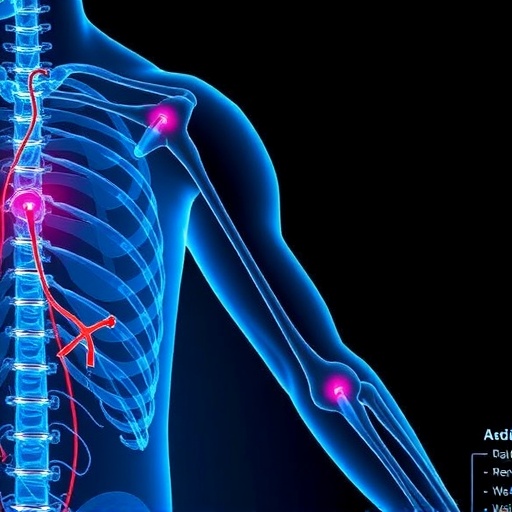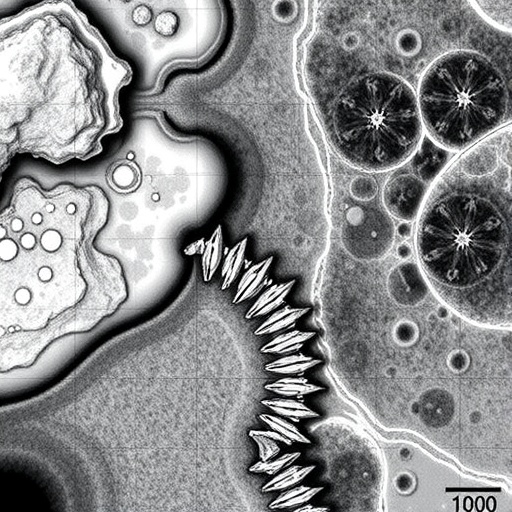In an unprecedented advance in the understanding of amyotrophic lateral sclerosis (ALS), a groundbreaking study published in Nature Communications uncovers a pivotal molecular pathway responsible for the neuromuscular denervation underlying this devastating neurodegenerative disorder. The research, led by Nógrádi, Molnár, Kristóf, and colleagues, reveals that the CCL2-CCR2 chemokine axis plays a critical role in driving synaptic disintegration at the neuromuscular junction, providing new avenues for therapeutic intervention.
ALS, characterized by progressive motor neuron degeneration leading to muscle paralysis and eventual respiratory failure, has long been a challenge for researchers seeking to unravel its precise cellular and molecular mechanisms. Although the loss of motor neurons has been clearly established as the core pathological hallmark, the early events that precede overt neuronal death remain elusive. This study shifts the focus to the neuromuscular junction—the specialized synapse connecting motor neurons to muscle fibers—where the initial disruptions in communication and connection appear to set the stage for subsequent neurodegeneration.
The CCL2-CCR2 axis, traditionally recognized for its role in immune cell recruitment and inflammatory responses, emerges here as a central player in neuromuscular pathology. The researchers demonstrated that CCL2, a chemokine ligand, and its receptor CCR2 are aberrantly upregulated in motor neurons and surrounding glial cells in ALS models. This overexpression correlates with pronounced neuromuscular denervation, a process wherein motor nerve terminals withdraw from muscle fibers, leading to functional synapse loss.
.adsslot_q9JO5spAPM{ width:728px !important; height:90px !important; }
@media (max-width:1199px) { .adsslot_q9JO5spAPM{ width:468px !important; height:60px !important; } }
@media (max-width:767px) { .adsslot_q9JO5spAPM{ width:320px !important; height:50px !important; } }
ADVERTISEMENT
Utilizing advanced mouse models genetically engineered to mimic human ALS, the team meticulously mapped the spatial and temporal dynamics of CCL2-CCR2 expression across disease progression. Early pre-symptomatic stages revealed subtle increases in CCL2 secretion, which were amplified as symptoms manifested. Importantly, pharmacological blockade of CCR2 signaling notably attenuated neuromuscular denervation and preserved muscle function, suggesting that this pathway’s activity is not merely correlative but causal in disease development.
A crucial innovation in this work was the deployment of high-resolution imaging techniques to observe neuromuscular junction architecture in vivo. By employing fluorescence microscopy combined with sophisticated neuronal tracing methods, the investigators documented the stepwise disassembly of nerve terminals concurrent with CCL2-CCR2 activation. These visuals not only confirmed biochemical findings but also provided compelling evidence for synaptic vulnerability as an early disease event.
The study further elucidated downstream mechanisms triggered by CCL2-CCR2 signaling. Activation of this axis instigated a cascade involving inflammatory mediators and microglial recruitment, establishing a neuroinflammatory milieu within the spinal cord microenvironment. This inflammation exacerbates synaptic stripping, reinforcing a vicious cycle that accelerates motor neuron degeneration. By dissecting this interplay between chemokine signaling and neuroimmune crosstalk, the research offers a holistic view of ALS pathology beyond mere neuronal demise.
Moreover, transcriptomic analyses of affected motor neurons revealed that CCL2-CCR2 activation disrupts cytoskeletal integrity and synaptic vesicle trafficking. These intracellular perturbations compromise axonal transport, a process essential for maintaining neuromuscular junction stability and nutrient exchange between nerve and muscle. The work ties molecular deficits directly to functional synapse failure, bridging the gap between cellular dysfunction and clinical symptoms.
Importantly, the team demonstrated that the modulation of CCL2-CCR2 is therapeutically feasible. Using monoclonal antibodies targeting CCR2, treatment delayed disease onset and improved survival rates in ALS model mice. This highlights the translational potential of these findings, positioning CCR2 antagonists as promising candidates for clinical trials aimed at halting or reversing early synaptic damage in ALS patients.
This discovery also reframes how neuroinflammation is viewed in ALS. While inflammatory responses have been implicated previously, the identification of a specific chemokine axis driving synaptic degeneration underscores a targeted mechanism rather than a broad unspecific immune activation. This specificity opens possibilities for precision medicine approaches where targeted blockade of chemokine receptors could mitigate neurodegeneration without compromising systemic immune functions.
The impact of this research transcends ALS alone. Since the CCL2-CCR2 axis is implicated in various neurodegenerative and inflammatory conditions, these insights could influence therapeutic strategies in diseases where synapse loss is a hallmark, such as multiple sclerosis and certain forms of peripheral neuropathy. Elucidating common molecular drivers of synaptic pathology could pave the way for unified treatment paradigms across neurological disorders.
Beyond molecular science, this study advances our understanding of synaptic homeostasis and neuron-glia interactions in health and disease. It highlights the delicate balance maintained at the neuromuscular junction and the devastating consequences when chemokine signaling is dysregulated. This knowledge enriches the broader neurobiology field, informing future research into synaptic resilience and repair mechanisms.
The publication also offers hope to the ALS community, which has long awaited breakthroughs that can alter the grim prognosis associated with this disease. By identifying a modifiable molecular target acting at early disease stages, the findings suggest potential diagnostic markers and therapeutic windows previously unrecognized. Early intervention in ALS, guided by biomarkers of CCL2-CCR2 activity, could revolutionize patient care.
Nógrádi and colleagues emphasize that while the blockade of CCR2 signaling offers promise, comprehensive clinical studies will be required to translate these preclinical successes into humans. Differences in immune system complexity, chemokine dynamics, and disease heterogeneity pose challenges that future research must address. Nonetheless, this work lays a solid foundation for such endeavors.
In conclusion, the elucidation of the CCL2-CCR2 chemokine axis as a driver of neuromuscular denervation in ALS represents a major leap forward in both basic neurobiology and clinical neurodegeneration research. This meticulously executed study blends genetic, pharmacological, imaging, and transcriptomic approaches to unravel a mechanistic pathway with profound implications. Its findings set the stage for new therapeutic interventions aimed at preserving neuromuscular connectivity, ultimately aspiring to halt or even reverse the progression of ALS.
As neuroscience continues to unravel the complexities of neurodegenerative diseases, the identification of targeted molecular drivers such as the CCL2-CCR2 axis offers a beacon of hope. The prospect of modulating inflammation-induced synaptic loss transforms ALS from an inexorable, untreatable illness into a condition where early and precise intervention could alter the trajectory of suffering. This work stands as a testament to the power of integrative biomedical research in tackling humanity’s most challenging diseases.
Subject of Research: Neurodegeneration; Amyotrophic Lateral Sclerosis; Neuromuscular Junction Pathology; Chemokine Signaling
Article Title: The CCL2-CCR2 axis drives neuromuscular denervation in amyotrophic lateral sclerosis
Article References:
Nógrádi, B., Molnár, K., Kristóf, R. et al. The CCL2-CCR2 axis drives neuromuscular denervation in amyotrophic lateral sclerosis. Nat Commun 16, 7053 (2025). https://doi.org/10.1038/s41467-025-62351-3
Image Credits: AI Generated
Tags: amyotrophic lateral sclerosis researchCCL2 CCR2 axis in ALSchemokine signaling in neurodegenerationearly events in ALS progressionglial cell involvement in ALSinflammatory responses in ALSmotor neuron degeneration causesneurodegenerative disorder interventionsneuromuscular denervation treatmentsneuromuscular junction pathologysynaptic disintegration mechanismstherapeutic targets for ALS





